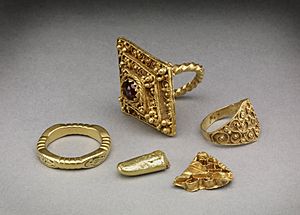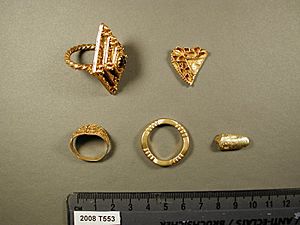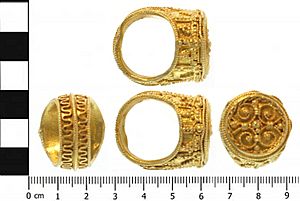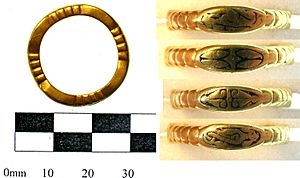West Yorkshire Hoard facts for kids
Quick facts for kids West Yorkshire Hoard |
|
|---|---|

2008 finds from West Yorkshire hoard
|
|
| Material | Gold; Lead |
| Period/culture | Medieval |
| Discovered | 2008–09 East of Leeds |
| Present location | Leeds Story Gallery, Leeds City Museum |
| Identification | SWYOR-F86A02; SWYOR-3B5652 |
The West Yorkshire Hoard is a collection of valuable gold items. It includes four gold rings and a small lead disc. A metal detectorist found these items near Leeds, West Yorkshire, between 2008 and 2009. This discovery was very important for understanding ancient treasures in northern England. It also added to the number of gold rings known from the early medieval period.
Contents
How the Hoard Was Found
A metal detectorist named Frank Andrusyk found the hoard. He made several separate searches between 2008 and 2009. First, he found four rings and a piece of a gold brooch. He told the Portable Antiquities Scheme about his discovery. This group then checked the field where the items were found. Six months later, in 2009, Frank found another gold ring. He also found a lead spindle whorl further down the same slope.
What's Inside the West Yorkshire Hoard?
The West Yorkshire Hoard contains six main items. There are four gold finger-rings. There is also a piece of gold cloisonné jewellery. Another item is a fragment of a gold ingot. Finally, there is a lead spindle whorl.
The items found in 2008 came in three groups over two days. These included a finger-ring with a red garnet stone. Another was a finger-ring with a large top part. A third was a finger-ring with black metal inlay called niello. Also found were a partial gold ingot and a piece of cloisonné. The items found in 2009 were a gold finger-ring with a round top. This ring had fancy gold wire and tiny gold balls as decoration. The lead disc, which was likely a spindle whorl, was also found then.
The Gold Finger-Rings
Ring 1: The Garnet Ring
This ring has a large diamond shape on top. Two smaller diamond shapes are stacked on it. The top diamond holds an oval garnet stone. The stone is set with a special "dog-tooth" edge. Twisted gold wire frames the stone. Small gold balls decorate the corners of the diamond shapes. More gold details, like twisted wire and tiny balls, fill the spaces.
The ring's band is unusual. It is made of twisted gold rods. These rods have curled ends that attach to the back of the top part. The decoration looks very new. This suggests the ring was not worn much. Experts believe this ring was made in the 10th or early 11th century.
Ring 2: The Small Gold Band Ring
This is the smallest ring in the hoard. It is made from a flat gold band. The band widens into a decorative top part. The ring shows signs of being worn. It is not as finely made as Ring 1 or Ring 3. It has upright, jagged gold wire decoration. This style of decoration was popular from the mid-9th to the 10th centuries.
Ring 3: The Round Bezel Ring
This is a large gold ring. It has a round top part, called a bezel. This bezel sits on a hollow, box-like base. The ring is covered with detailed decoration. This decoration is made from tiny gold balls and twisted gold wire. Some people think the twisted gold wire looks like a vine. Vines were a common symbol in religious art.
When you move the hollow ring, it seems to have something inside. X-ray scans show it might be something natural, like a plant piece. One idea is that this ring was used to hold a relic. A relic is a special object from a holy person or event. A few similar rings exist. This suggests it was made in the 9th, 10th, or 11th centuries.
Ring 4: The Niello Pattern Ring
This gold ring is quite worn. It has four decorated sections. These sections show patterns in the Trewhiddle style. Two sections have animal shapes, and two have plant designs. This style of decoration was used from the 9th to the 10th century. This means this ring was made earlier than the other three rings.
Other Interesting Objects
The Cloisonné Fragment
This small gold piece was once part of a larger item. It might have been a brooch. It would have had glass or jewels set into it. These are now missing. But the spaces where they sat show marks. These marks suggest the pieces were pried out. This fragment was made in the 7th or 8th centuries.
The Gold Ingot Piece
This is a broken piece of a gold bar, called an ingot. It has clear cut marks. Its shape matches other gold ingots from the 9th to 11th centuries.
The Lead Disc
This small lead disc is most likely a spindle whorl. A spindle whorl is a weight used to help spin thread.
Bringing the Hoard Home
In 2011, Leeds Museums & Galleries started a campaign. They successfully raised £171,310. This money allowed the hoard to stay in the region. It became public property and is now shown at Leeds City Museum. Many groups helped fund the purchase. These included the National Heritage Memorial Fund and the Wolfson Foundation. The Leeds Philosophical & Literary Society also helped. The Friends of Leeds City Museums ran a special fundraising campaign. The city officially bought the hoard in 2012.
Seeing the Hoard on Display
The hoard is on display at Leeds City Museum. More funding was received from the Headley Trust. This money helped create a special display. It includes custom stands for the items. There are also 3D models of the hoard. Visitors can explore these models digitally.





